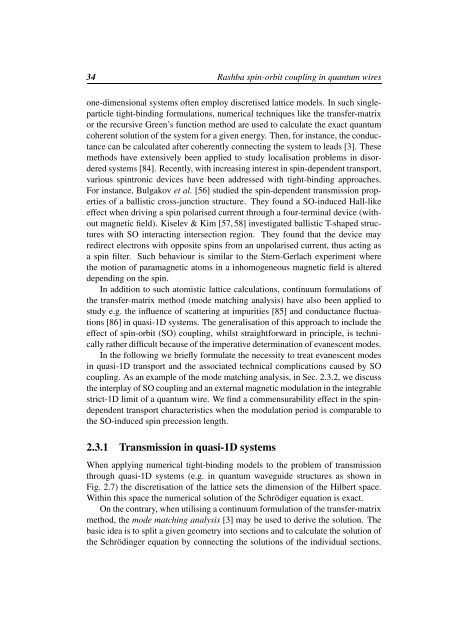Spin-orbit coupling and electron-phonon scattering - Fachbereich ...
Spin-orbit coupling and electron-phonon scattering - Fachbereich ...
Spin-orbit coupling and electron-phonon scattering - Fachbereich ...
Create successful ePaper yourself
Turn your PDF publications into a flip-book with our unique Google optimized e-Paper software.
34 Rashba spin-<strong>orbit</strong> <strong>coupling</strong> in quantum wires<br />
one-dimensional systems often employ discretised lattice models. In such singleparticle<br />
tight-binding formulations, numerical techniques like the transfer-matrix<br />
or the recursive Green’s function method are used to calculate the exact quantum<br />
coherent solution of the system for a given energy. Then, for instance, the conductance<br />
can be calculated after coherently connecting the system to leads [3]. These<br />
methods have extensively been applied to study localisation problems in disordered<br />
systems [84]. Recently, with increasing interest in spin-dependent transport,<br />
various spintronic devices have been addressed with tight-binding approaches.<br />
For instance, Bulgakov et al. [56] studied the spin-dependent transmission properties<br />
of a ballistic cross-junction structure. They found a SO-induced Hall-like<br />
effect when driving a spin polarised current through a four-terminal device (without<br />
magnetic field). Kiselev & Kim [57, 58] investigated ballistic T-shaped structures<br />
with SO interacting intersection region. They found that the device may<br />
redirect <strong>electron</strong>s with opposite spins from an unpolarised current, thus acting as<br />
a spin filter. Such behaviour is similar to the Stern-Gerlach experiment where<br />
the motion of paramagnetic atoms in a inhomogeneous magnetic field is altered<br />
depending on the spin.<br />
In addition to such atomistic lattice calculations, continuum formulations of<br />
the transfer-matrix method (mode matching analysis) have also been applied to<br />
study e.g. the influence of <strong>scattering</strong> at impurities [85] <strong>and</strong> conductance fluctuations<br />
[86] in quasi-1D systems. The generalisation of this approach to include the<br />
effect of spin-<strong>orbit</strong> (SO) <strong>coupling</strong>, whilst straightforward in principle, is technically<br />
rather difficult because of the imperative determination of evanescent modes.<br />
In the following we briefly formulate the necessity to treat evanescent modes<br />
in quasi-1D transport <strong>and</strong> the associated technical complications caused by SO<br />
<strong>coupling</strong>. As an example of the mode matching analysis, in Sec. 2.3.2, we discuss<br />
the interplay of SO <strong>coupling</strong> <strong>and</strong> an external magnetic modulation in the integrable<br />
strict-1D limit of a quantum wire. We find a commensurability effect in the spindependent<br />
transport characteristics when the modulation period is comparable to<br />
the SO-induced spin precession length.<br />
2.3.1 Transmission in quasi-1D systems<br />
When applying numerical tight-binding models to the problem of transmission<br />
through quasi-1D systems (e.g. in quantum waveguide structures as shown in<br />
Fig. 2.7) the discretisation of the lattice sets the dimension of the Hilbert space.<br />
Within this space the numerical solution of the Schrödiger equation is exact.<br />
On the contrary, when utilising a continuum formulation of the transfer-matrix<br />
method, the mode matching analysis [3] may be used to derive the solution. The<br />
basic idea is to split a given geometry into sections <strong>and</strong> to calculate the solution of<br />
the Schrödinger equation by connecting the solutions of the individual sections.
















